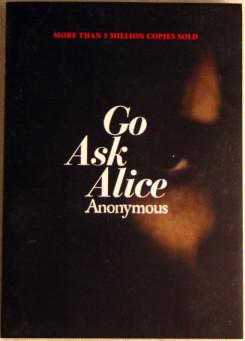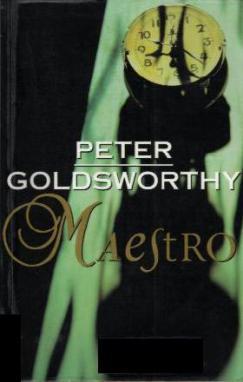Although I spend most of my working day in the classroom I sometimes cast my mind back to the time when I could (and often did) get detention for writing on the desks. I’d always been a reader and came across a range of different materials in the assigned reading. We’d already covered three of them, and here’s some more.
Go Ask Alice
Anonymous

For year 8 and 9 (the first two years of high school in Australia) I had a rather young English teacher, and like most young teachers she like to go with something a bit edgy and hard hitting. That led us to a class set of Go Ask Alice, and at the time it was pretty extreme. It’s the diary of a teenaged girl who manages to get herself invited to the same party as her crush, where she unwittingly takes LSD as part of a party game. From here she winds up on a world record downward spiral, going from precocious youth to addict in a matter of pages. Sex, relationships breaking apart, teen pregnancy, living on the streets…even her grandfather’s heart attack all come from this one drug experience. Even when she kicks the habit a bunch of evil drug users sneak into a house she’s babysitting at and spike her food resulting in such a bad trip she gets locked in an asylum.
Shortly after it was released the books ‘editor’, psychologist Beatrice Sparks, was revealed to be the author of this entirely fictional account. As a naive young reader I found it to be amazing stuff, but when I found out it was made up it lessened the impact. In hindsight the ‘Alice’ is such a simplistic character and the events of the story so implausible that it’s little more than ham-fisted anti-drug propaganda. If you’re trying to get teens on side with the dangers of drugs outright lying to them isn’t going to help you. I still encounter people who believe it to be real, and they’re never happy about being mislead. Never read it again.
Z For Zachariah
Robert C. O’Brien

As far as the post-apocalyptic sub-genre of science goes, this is pretty unique, but you’d expect something interesting from the author of Mrs. Frisby and the Rats of NIMH (adapted into the fantastic animated film Secret of NIMH). Set during the 1970s it follows the story of the 16 year old Ann. A nuclear war has wiped out the people of the United States, and possibly the world, and Ann’s family’s farm was protected from the radiation by the high walls of the surrounding valley. A year after her family drove off looking for other survivors she remains, surviving by working the farm. One day a stranger arrives in a radiation suit. At first Ann is excited to have some company, but caution holds her back. Eventually they meet and their relationship goes from cautious to friendly to threatening. It becomes a game of survival and a battle for resources in the valley before one of them must make a difficult decision.
This one is good. It’s a richly detailed story and well fleshed out characters. It’s not often that a story with only two people in it and lots of emotional reflection can hold the attention of a ratbag 13 year old more concerned with drawing comics during class. The balance between the character work and the survival aspects of the scenario is well maintained, and it’s easy for the reader get drawn into the contained world that O’Brien has conjured up. So imaginative it is, I used it as a set task for my own classes when I became an English teacher. (If you’re wondering how someone who drew comics in class became a teacher themselves, it’s because I was bored. I needed more challenging materials as a reader at that age.)
I do have a confession to make though. I’ve never finished it. Not when I was a student or when I was a teacher using it in the classroom. I know how it ends, but there’s a lull following the revelation in the second act that I never got through. One day I’ll finish it.
Maestro
Peter Goldsworthy

If there’s one thing teachers love, it’s books about the holocaust. This slender volume was a staple of the Australian classroom throughout the 1990s and possibly right up until the publication of The Boy in the Striped Pyjamas. The story of this one follows a high school student, making it all the more appealing to a teacher trying to get their students reading, and for the most part it does capture the mindset of an Australian teen pretty well. The protagonist Paul Crabbe is a relatable sort in that he’s driven by his hormones and desire to fit in with his peers. He has a talent for the piano and (in addition to joining a high school band) is put under the tutelage of Herr Eduard Keller. Although Paul dislikes Keller’s heavy handed and critical technique he later forms a bond with his teacher and learns of his past in Austria, how he once played for Hitler in the mistaken belief that doing so would spare his Jewish family. It is eventually revealed that Keller survived a death march at the end of the war, but lost everyone important to him. Paul eventually matured and became a concert pianist, remembering the impact Keller had on his life.
Splooge. That’s what I mostly remember about this book, and not especially fondly. The character development, the historical context, the contrasting themes of the novel…these were all pretty good but without the excessive splooge commentary it wouldn’t have stood out in my mind so much. I should explain (about the splooge). In the early chapters of the book the character Paul become enamoured with a girl sitting in front of him in class. this leads to a series of wet dreams which dominate the early third of the book. Fortunately we are spared the details of the dreams themselves but not the aftermath, as Paul tries to smuggle his bedsheets into the washing machine every morning. I recall a particularly vivid description by Paul of his bedsheets becoming so covered with dried semen that the sheet could be held rigid by the end of the week.
Surprisingly no-one that I knew raised their distaste for this focus with the school or the teacher. It was glossed over in class discussions but I recall some muttered comments from my classmates who weren’t particularly fond of this detail of the story. Wiki tells me that it played a significant part in the Australian high school curriculum, so I wonder if there’s a whole generation of adults who aren’t talking about having read this book due to suppressed memories. It was a good story and great example of character development in the end, but I wouldn’t ask kids to read it.

